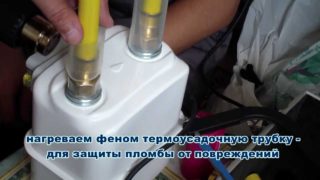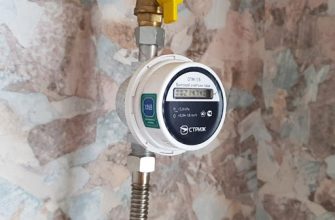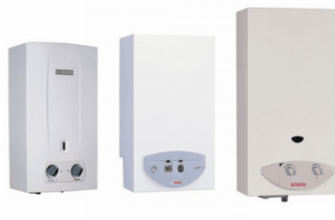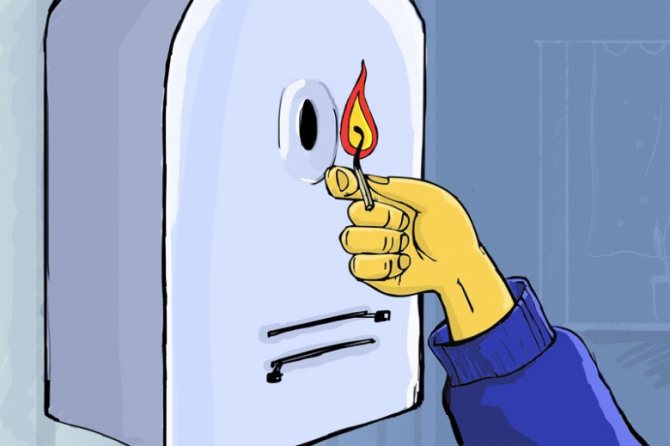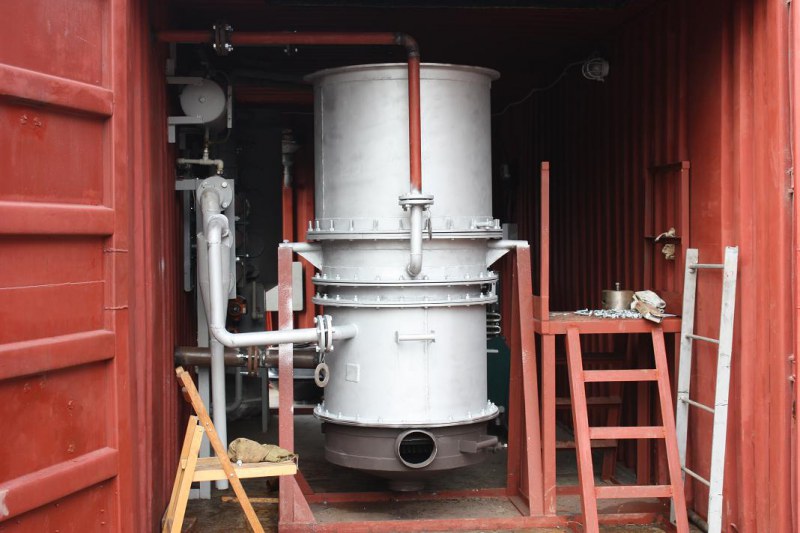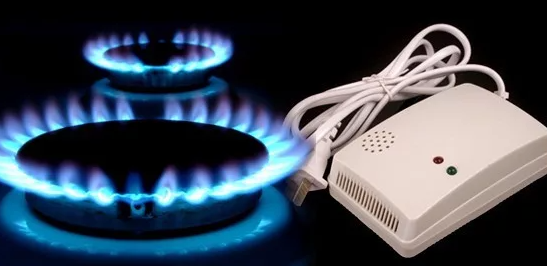Fifty years ago, devices were connected to the gas main in a rigid way - they connected the device directly to the pipe without any flexible adapters. As a result, the stove or other equipment could not be moved a centimeter. Now the approach has changed - flexible gas lines are widely used, which solves this problem.
Varieties of gas connections
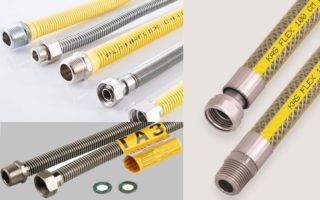
The gas line is a flexible hose made of metal, rubber or PVC. Its main advantage and difference from the traditional rigid method of connecting devices to a gas pipeline is the ability to move already connected devices to a distance that allows the length of the hose.
Gas hoses are made from different materials, so they differ in technical characteristics, service life and conditions of use.
The simplest budget option is rubber hose... It is a rubber sleeve reinforced with textile thread. Despite its good elasticity, over time, the liner begins to crack, due to which gas leakage is possible. The service life of a modern rubber-fabric sleeve is up to 5 years (previously up to 2 years).
Rubber-fabric hoses are used only for connecting a gas cylinder on the condition that they are replaced with new ones in accordance with the terms recommended by the manufacturer.
Metal braided rubber grommet made of vulcanized rubber. Outside, it is protected by a layer of interwoven steel threads, and inside the surface is covered with polymer materials. Such a hose should be connected to the device through a special dielectric gasket, since steel serves as a conductor of electricity. The fact that the product is intended for a gas pipeline is evidenced by the color of the braid - a yellow thread woven into the base.
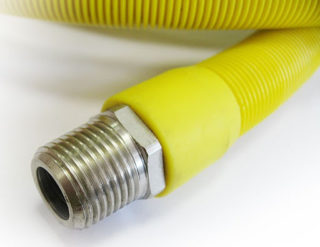
Flexible bellows-type gas connection combines two characteristics: practicality and safety. In the manufacture of bellows liners, stainless steel and polymer materials are used. The surface is reinforced with corrugation, which is reinforced with wire. The latter can withstand high pressure. The hoses are connected using robust brass or steel fittings with threads and gaskets. Corrugated stainless steel gas hoses stretch significantly, bend at almost any angle. If the product stretches no more than 50%, its strength and elasticity are retained.
There are liners protected by an additional metal sleeve or polymer coating. Upgraded models are equipped with a thermal safety valve to prevent gas flow when the temperature rises. The advantages of bellows-type gas hoses are sufficient.
Oxygen hoses belong to another type of gas supply. They are characterized by durability and resistance to high pressure. However, it is recommended to install them only as a temporary option for connecting a gas cylinder, and it is imperative to install a gas reducer at the same time.
Reinforced PVC hose appeared not so long ago, so there may be problems with admission to operation. In terms of service life, PVC hose can compete with a gas bellows line. It consists of two layers of PVC: black and yellow.
Selection rules
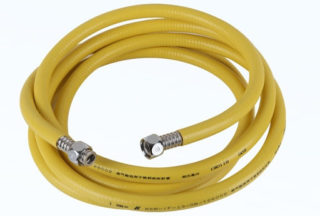
Gas connections should be purchased in specialized stores, where the quality of products can be confirmed by SNIP and GOST certificates, permission of Rostekhnadzor of Russia. Each product must be accompanied by a passport, which indicates the date of production, service life and the recommended replacement period. Before purchasing, inspect the product for damage. Chinese hoses are not recommended for purchase because they wear out quickly.
The assortment is represented by products of various lengths: from 30 cm to 7 m. It is necessary to choose a hose according to the length so that you do not have to use the second one. Extension of sleeves by connecting to each other is not allowed. If the distance between the gas pipeline and the device does not allow the use of one hose, the eyeliner is extended by means of a metal pipe.
The piping should connect the pipeline and the device loosely enough, without tension. The hose is slightly shortened after gas supply due to pressure.
When connecting a gas stove, the length of the connection must not exceed 2 m. This is a European standard.
The value is given to the diameter of the section. A full gas supply is possible provided the cross-sectional size is at least 10 mm. The ends of the hoses can be fitted with two nuts or one nut and union. The nut has an internal thread, and the nipple has an external thread. If the output of the device is straight, a fitting-angle is used for connection. The nut and the union are selected exactly according to the size.
Chinese manufacturers counterfeit well-known European brands, so the purchased product must be carefully checked:
- make sure of the quality by comparing the passport characteristics with real ones;
- examine the quality certificate;
- inspect.
The Chinese counterfeit is short-lived and can release toxic substances into the air. It happened that products were made from metals with radioactive impurities.
Well-known brand eyeliners that sell at a suspiciously low price are 100% falsified.
You can opt for an ordinary rubber-fabric hose, but you need to constantly monitor the degree of its wear, control whether there is a smell of gas. The most optimal in terms of price-quality ratio is a reinforced hose, the bellows-type liner is distinguished by the longest service life and reliability. Moreover, the fitting must be connected to the corrugation by welding or be one-piece. You should not take the eyeliner, where the fitting and the corrugation are glued to each other.
Installation features
- Lay the sleeve in an accessible place so that it can be easily replaced if necessary. This is also a safety requirement: this way you can detect the wear of the liner in time.
- Tighten the connections tightly, but do not use excessive force to avoid stripping the threads.
- Connect only suitable metals to each other: brass with copper, steel with steel. It is unacceptable to combine copper with steel - these metals form a galvanic pair.
- Observe the bending radius: it should not be less than three times the diameter.
- Lay the sleeve without tension, kinks, twisting.
- Protect metal from condensation, which leads to corrosion and premature hose failure.
- It is imperative to install a dielectric gasket between the supply line and the tap - it prevents the accumulation of stray currents, which can cause overheating and melting of the rubber.
If you follow all the recommendations, the gas hose will last as long as it should, and even more.
Advantages and disadvantages of gas lines
It is necessary to consider the advantages and disadvantages of gas connections, taking into account their type and material of manufacture.
| Type of gas supply | Dignity | disadvantages |
| Rubber-fabric hose |
|
|
| Metal braided rubber liner |
|
|
| Bellows type lead-in |
|
|
| Oxygen hoses |
|
|
| Reinforced PVC hose |
|
|
To connect gas equipment, only a pipe with a corresponding marking is suitable. Do not use water hoses in the gas system.
Safety regulations
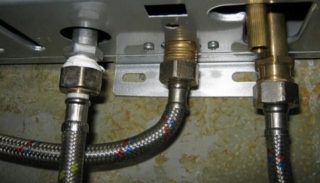
A negligent attitude towards gas appliances, the choice of equipment and unprofessional installation are fraught with gas leakage. It is recommended to observe the following safety rules:
- The flexible line must not be extended with another hose. In each case, only one hose of the correct length is used.
- The liner must be made of materials that are resistant to corrosion and oil.
- The characteristics of the hose must match the parameters of the system.
- It is forbidden to hide the eyeliner with a box, place it in a strobe.
- It is necessary to periodically change the eyeliner in accordance with the terms indicated by the manufacturer.
If you have doubts about the correct installation or your own strength, you should contact a licensed specialist who professionally deals with the connection of gas equipment.
Self-connection instructions
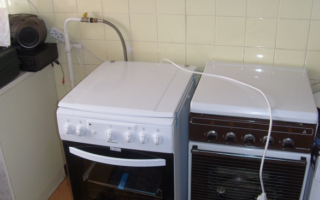
You can connect a gas appliance, for example, a stove, to a drop (a branch from a gas riser), if you have a special tool and skills to work with it:
- With the help of the valve, the gas supply is shut off.
- The device that will be connected to the gas pipeline is installed and leveled.
- A sealant, for example fum tape, is screwed onto the hose fitting, and the fitting itself is screwed into the tap at the lowering.
- The hose is connected to the equipment. The connection is also pre-sealed. If the diameters do not match, use an adapter.
- Be sure to check the connections for leaks. This will require a soapy solution and a brush. The gas supply is resumed, and the solution is applied to the joint with a brush. If it bubbles, the assembly is not tight enough, it is necessary to add one or two turns of the seal.
It is difficult for a layman to choose the right flexible gas supply line among a wide range. You need to know how they differ and what equipment they are suitable for. This aspect and the apparent ease of installation lead to the fact that the sleeve is selected and installed incorrectly.
Monitoring the condition of the hose during the entire operation and checking for leaks after installation are mandatory.

